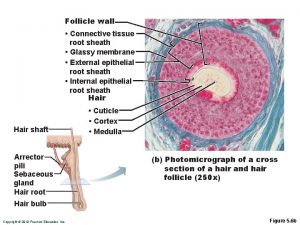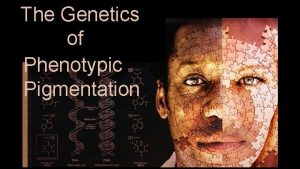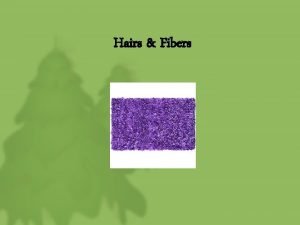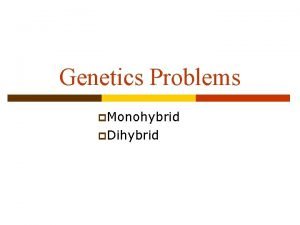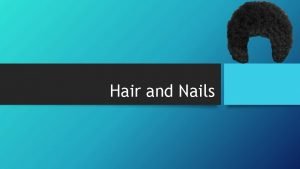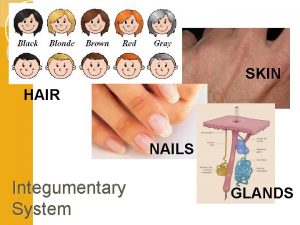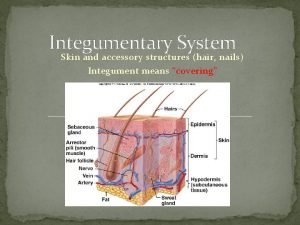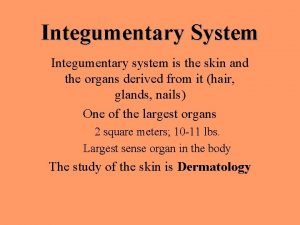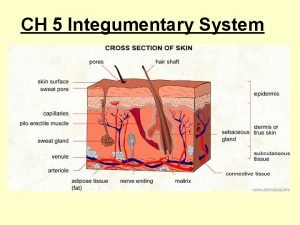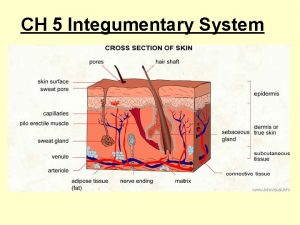INTEGUMENTARY SYSTEM Structures of Integumentary system Skin Hair





















- Slides: 21

INTEGUMENTARY SYSTEM


Structures of Integumentary system • • • Skin Hair Nails Oil glands Sweat glands

Function of Integumentary system • Functions: 1) physical barrier b/w the inside and outside of the body. 2)Contains nerve endings: sense, heat, pressure and pain. 3)maintain homeostasis by regulating temperature, retaining body fluids, and eliminating wastes

Skin • largest organ of the body • Varies in thickness from 1/50 inch (0. 5 mm) in the eyelids to 1/4 inch (6. 3 mm) in the soles of the feet • Changes in the skin often indicate the presence of other body system disorders including anemia, respiratory disorders, liver disorders, cancer, and shock. (More to come on this topic later…. )

Hair, Nails, Oil & Sweat glands • Hair reflects harmful UV rays. • Nails protect sensitive nerve endings in fingertips. • Oil glands keep skin supple and soft, capable of moving and stretching • Sweat glands help us regulate our temperature.

Layers of Skin Epidermisoutermost, made of mostly dead keratinized cells. Dermismiddle layer- nerves, oil and sweat glands, capillaries. Subcutaneous Fatfat as insulation, blood supply

Epidermal Layer:

Epidermal Layer • Basal layer: deepest layer of epidermis, basal cells divide quickly and push older cells to the top where they die and slough off. (keeps us waterproof) • Langerhans Cells: active in the capture, uptake & processing of antigens. (Fight off bad guys like bacteria)

Epidermal Layer • Melanocytes: melanin producing cells found in epidermis. The pigment melanin is responsible for determining skin color. • Merkle cells: Aid in the reception of light, gentle pressure sensations.

Epidermal Layer • Skin Color: – Product of the amount of melanin in the skin. (melanocytes make melanin, more melanin you make, the darker your skin) -- Dark enough to prevent UV damage to underlying cells, light enough to allow UV in to produce Vitamin D.

Skin color map (indigenous people). The twin role played by the skin- protection from excessive UV radiation and absorption of enough sunlight to trigger the production of vitamin D – means that people living in the lower latitudes, close to the Equator, with intense UV radiation, have developed darker skin to protect them from the damaging effects of UV radiation. In contrast, those living in the higher latitudes, closer to the Poles, have developed fair skin to maximize vitamin D production.

Albinism A genetic mutation that causes an animal not to produce any melanin or other pigments. Dangerous because skin is exposed to UV radiation. Nystagmus and Photophobia of the eye are common.


Dermal Layer: blood vessels • Skin controls heat loss via capillaries: – When hot, capillaries will vasodilate to release heat from the blood stream and out of the body through the epidermis. – When cold, capillaries will vasoconstrict to keep heat locked inside the body.

Collagen, elastin, keratin

Dermal Layer: proteins • Collagen, elastin, keratin • Keratin: fibrous protein; main structural component of hair and nails • Collagen: structural component of connective tissue; scaffold for support and structure. • Elastin: elastic protein that allows skin to return to its normal position after movement

Dermal Layer: Glands • Eccrine Sweat glands are all over the skin to release water, salts, and urea. Help to cool the body. • Appocrine sweat glands are in the armpits and groin. They produce a thick milky protein-based sweat that has an odor.

Dermal layer: Glands • Sebaceous Oil Glands produce sebum. -- - associated hair follicle. Keeps skin soft, and hair from becoming brittle. • Blackheads - accumulation of dried sebum. • Whitehead- sebum trapped under layer of skin cells • Acne, active bacterial infection of the oil glands.

Skin Cancer • Wear sunscreen: SPF 15 or greater Notice moles… • that change • that are larger than a pencil eraser • that have jagged edges

Burns The Rule of Nines is used to estimate the amount of skin that has A burn that affects only the epidermis is “ 1 st degree” and will generally heal in 5 -7 days. The epidermis and dermis is “ 2 nd degree. ” All three layers is “ 3 rd degree. ” been burned. Skin grafts may be necessary to quickly cover burned skin so it does not become infected.
 Skin hair and nails system
Skin hair and nails system Thin skin vs thick skin
Thin skin vs thick skin Thin skin vs thick skin
Thin skin vs thick skin Modelage masks milady
Modelage masks milady Skin structures
Skin structures Skin hair and nails assessment
Skin hair and nails assessment Milady chapter 22 review questions
Milady chapter 22 review questions Example of homologous structure
Example of homologous structure Hair glassy membrane
Hair glassy membrane Dark hair and blonde hair parents
Dark hair and blonde hair parents Principles of tacheometry
Principles of tacheometry When everybody is praising the sun the rebel
When everybody is praising the sun the rebel Hair grows in diagonal tubes called hair
Hair grows in diagonal tubes called hair Morphology hair
Morphology hair Heterozygous tabby x stripeless
Heterozygous tabby x stripeless Hirsuities
Hirsuities Epidermis
Epidermis Integumentary system vocabulary
Integumentary system vocabulary Swine integumentary system
Swine integumentary system Integument adalah
Integument adalah Epidermis layers
Epidermis layers The integumentary system exercise 7
The integumentary system exercise 7








